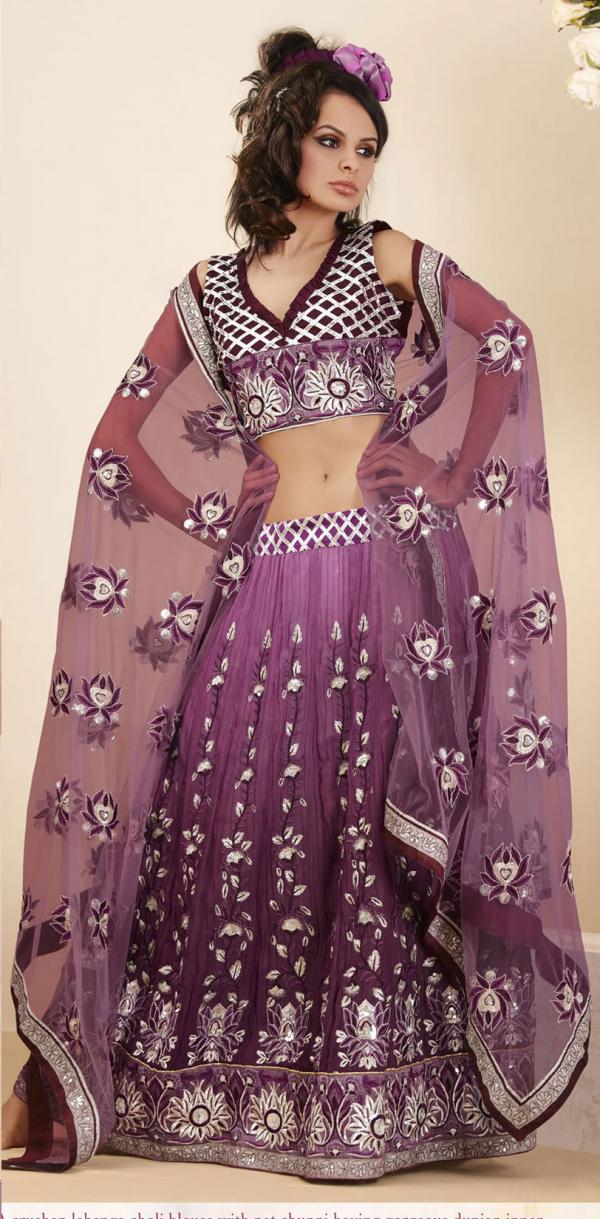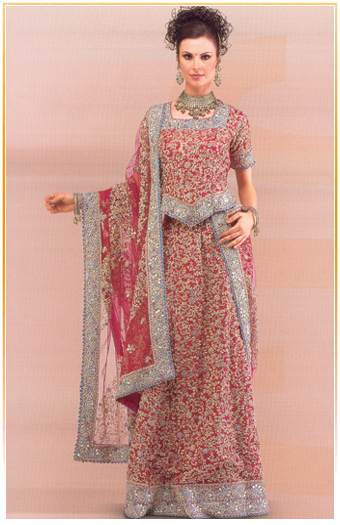Ghagra Choli Biography
Source (google.com.pk)Gagra choli or Ghagra choli, which is also known as Lehenga choli, is the traditional clothing of women in Rajasthan Gujarat,Madhya Pradesh, Uttar Pradesh, Bihar, Haryana, Himachal Pradesh and Uttarakhand. Chaniya choli is another term commonly used to refer it. It is a combination outfit of a Lehenga, tight Choli and a Dupatta.A choli (Hindi: चोली), (ravike in South India Telugu: రవికె, Kannada: ರವಿಕೆ) is a midriff-baring blouse shell garment in the Indian sari costume worn in India, Pakistan, Sri Lanka, Bangladesh, and other countries where the sari is worn. The choli is cut to fit tightly to the body and has short sleeves and a low neck. The choli is usually cropped, allowing exposure of the navel; the cropped design is particularly well-suited for wear in the hot South Asian summers. Cut-out backs and front-opening buttons are some of the features of contemporary designs.
Illustration of different regional variations of Ghagra choli worn by women in India.
Lehenga or Ghagra is a form of skirt which is long, embroidered and pleated. It is worn as the bottom portion of a Gagra choli. It is secured at the waist and leaves the lower back and midriff bare.The ancient version of skirt or Ghagri evolved from Bhairnivasani, which in turn evolved from the Antariya when stitched on one side became tabular and was worn gathered together at the waist, and held by a girdle. This was one of the earliest forms of a clumsily stitched skirt. It was worn using drawstring or nada. The ghagri was a narrow skirt six feet long the same length as original antariya. This style can still be seen worn by Jain nuns in India.Fabrics
The lehengas are made of a number of fabrics such as Silk, Cotton, Khadi, Georgette, Crape, Net, Satin, Brocade and Chiffon. Even though designers have successfully used the various kinds of fabrics for making the lehenga, silk is still the most preferred fabric.Decorative stitching
Apart from the fabric, decorative stitching patterns also play a role. Lehengas come with a wide variety of decoration and embroidery work like Gota, Phulkari, Shisha, Chikankari, Zari, Zardozi, Nakshi, Kundan, etc. For festivals like Navratri, the ethnic Shisha embroidery is popular with a bit of patchwork. For formal wear and weddings, the embroidery is heavier in pearls, silk, sequins and zari.
Kutch embroidery is an evolving expression of the craft and textile traditions of the Rabaris, a nomadic tribe in Gujarat.Kutch work is unique in the sense that a net is woven on a cloth using thread.The net is then filled in using the same thread by intricate interlocking stitches. The patterns are usually built around geometric shapes.This embroidery follows its own traditional design logic and juxtaposition of colours and motifs.The Rohanas tribals of Kutch specialise in skirt work. The Sodhas use a geometric style for their embroidery. The Garacia Jats are experts in tiny embroidery on the yoke, which intermingles with red, orange, blue and green threads. The Dhanetah Jats love embroidering broad pear-shaped mirrors using orange, black, yellow and red in chain stitch.Significance in rite of passage
In South India coming of age ceremony or rites of passage (Langa Voni Telugu: లంగా వోని, Pattu Pavadai Tamil: பட்டு பாவாடை, Langa Davani Kannada: ಲಂಗ ದ್ವನಿ). Is celebrated when a girl reaches puberty. She wears Langa Voni given by her maternal grandparents, which is worn during the first part of the ceremony and then she is gifted her first Sari by her paternal grandparents, which she wears during the second half of the ceremony. This marks her transition into womanhood.
The tradition of giving Langa Voni by maternal grandparents begins with the girl's first naming ceremony Namakaran and her first rice feeding ceremony called Annaprashana. She receives her last one at her coming of age ceremony. Langa Voni is traditional clothing for unmarried girls in South India.Luanchari
Pahari painting depicting women in Luanchari. ca.1760
Luanchari (Hindi:लौन्चारी) is a full-dress garment. The Luanchari is made up of two parts, the upper part is called choli it is made of the same fabric as of the lehanga but it is not uncommon to find the two pieces of the garment in different colours. The choli is stitched to the lehanga, to make one-piece luanchari. That one finds commonly worn by the women in Pahari miniatures, and is quite similar to lehanga. It takes well over 16 to 21 yards to make a complete Luanchari. It is traditional garment worn by Gaddis of Himachal Pradesh.
[edit]Festive attire
The lehenga choli is the favourite female apparel worn during festivals, weddings or special events in India. This is due to traditions as well as of the fact that it is available in a number of fabrics with many different decorative choices. Traditionally the sari and the lehenga choli are the most popular garments for the bride in India. But it is a common bridal attire mostly in North India.It is the traditional wear of Garba ( most famous festival of Gujarat).
Ghagra Choli
 |
Ghagra Choli |
 |
Ghagra Choli |
Ghagra Choli |
Ghagra Choli |
 |
Ghagra Choli |
Ghagra Choli |
Ghagra Choli |
 |
Ghagra Choli |
 |
Ghagra Choli |
 |
Ghagra Choli |
No comments:
Post a Comment